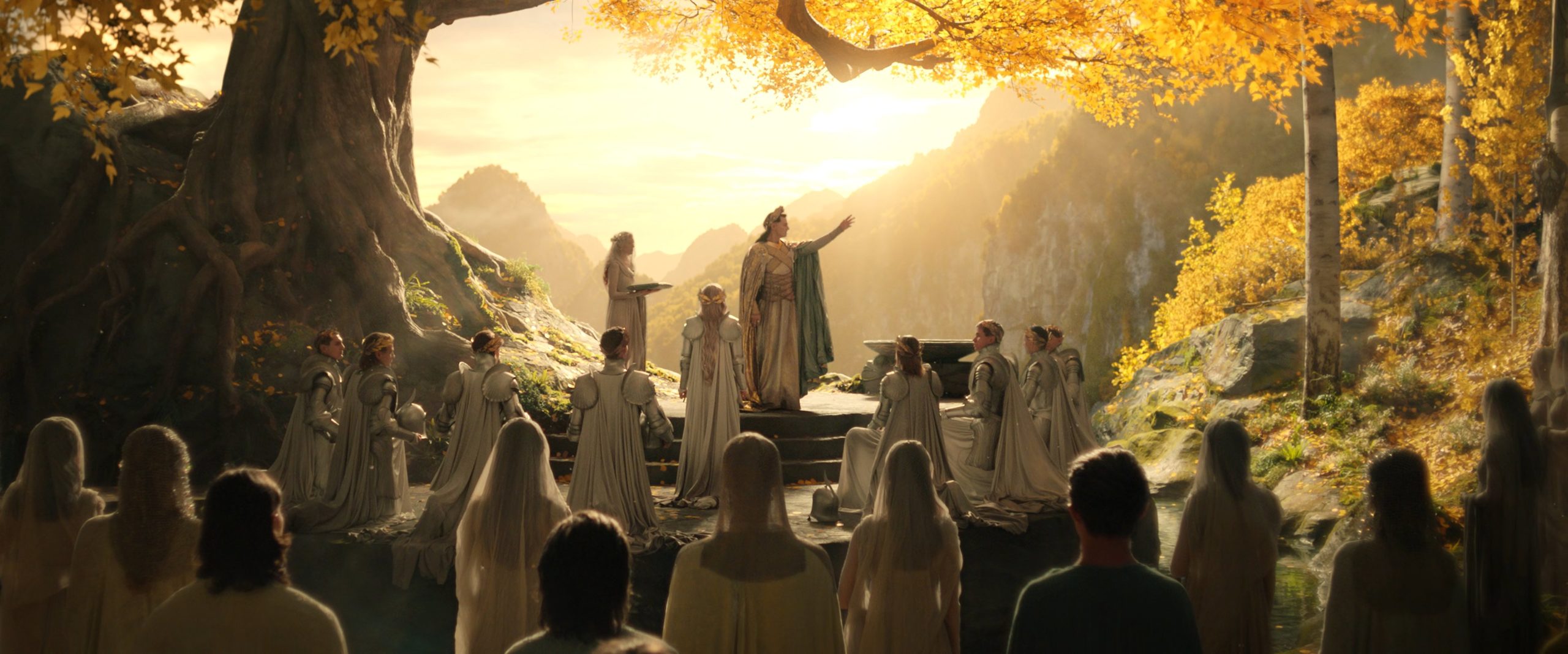
How Closely Does The Rings of Power Follow What Tolkien Actually Wrote? (Part IIa – Characters: Elves)
In this series of articles I am considering the locations, characters, and events of the first season of The Rings of Power with regard to how well they match anything Tolkien actually wrote about the Second Age (or First Age, where relevant), whether or not it is a work Amazon officially has access to. Previously I wrote about the locations in The Rings of Power. In these next few articles I will go over the characters in The Rings of Power. It may be helpful to compare this article with one I wrote before the show aired, which only covered Second Age characters that Tolkien himself wrote about.
As I mentioned in that article, one of the first things we were told about the Amazon series, even before it was announced that the show would take place in the Second Age, was that it would feature “characters [we] love”. The revelation of the maps and the announcement “Welcome to the Second Age” put that earlier statement in context, and anyone could have guessed that Elrond and Galadriel would be at least two of those characters. Sauron, of course, would also need to show up, being the principal villain from the time period. But what exactly does an Amazon executive mean by “characters you love”? In Tolkien fandom it seems no character is too obscure to be without some kind of following. Celeborn only appears briefly in the New Line films. Would he be given an expanded role in the show? It would seem unthinkable to have a Second Age show without Gil-galad, or a show about the Rings of Power without Celebrimbor, even though they may be unfamiliar to casual fans. Would they be major characters in the show? What about characters such as Glorfindel, Celebrían, or Narvi, who have less of a known impact on events of the Second Age, yet are still beloved by many? Or even rather obscure characters (to most fans) such as Pengolodh? And then again, what about extremely well-known characters who likely were not around in Middle-earth during the Second Age, but we can’t really say for certain, such as Legolas? Or even ones who weren’t, such as Aragorn or Samwise Gamgee? Would they be used as a framing device?
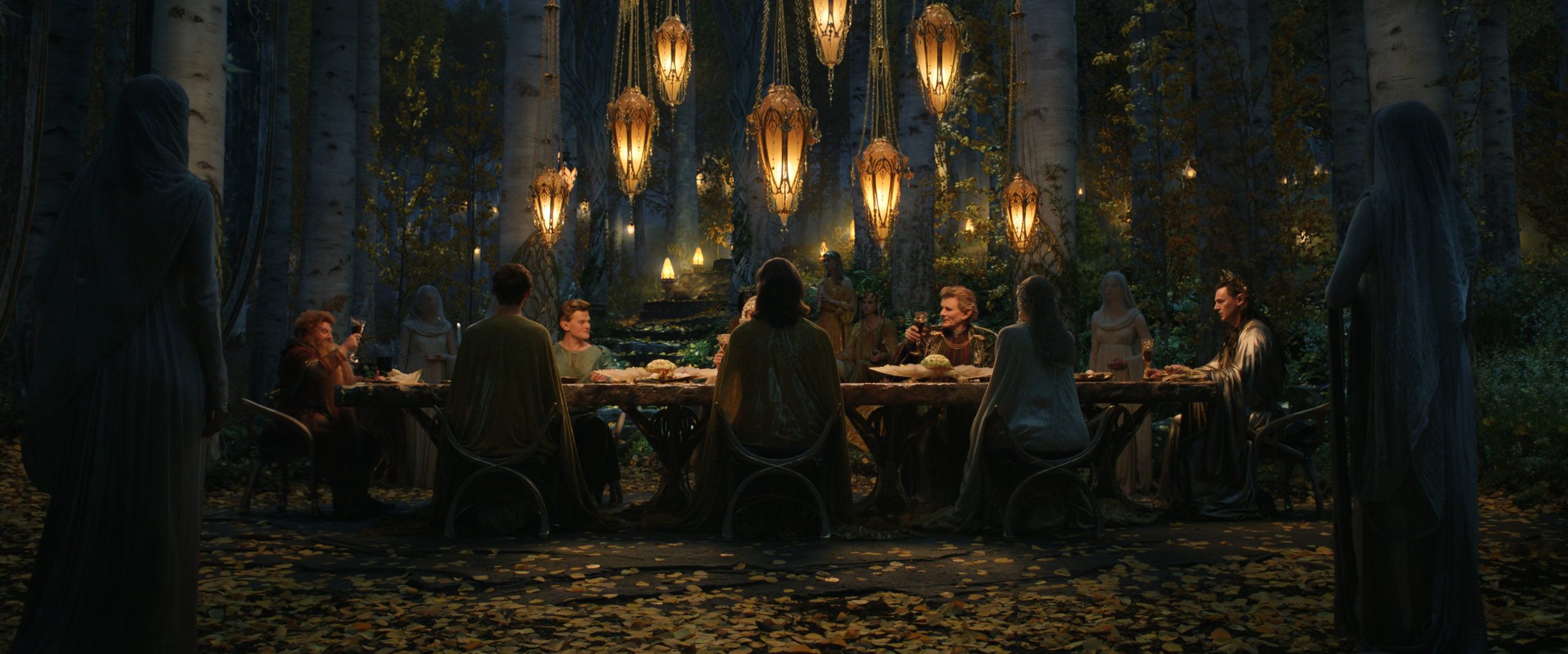
Now those questions have largely been answered, at least for the first season of the series. We have seen a number of characters taken from the works of Tolkien, as well as a number of original characters introduced by the Amazon Studios writing team. Interestingly for an adaptation, I haven’t really noticed any composite characters so far (with perhaps a few exceptions I will note later), but perhaps this is because Tolkien’s Second Age writings are already so sparse that there isn’t much need to combine characters.
The Rings of Power contains a large cast of characters, even if we ignore those with little screen time or few spoken lines. In these articles I intend to cover all of the named characters who appear in the first season of the show, because if a name is given, it is clearly either taken from Tolkien or it is not. For the most part I will ignore unnamed characters, since presumably Tolkien’s world contains many more inhabitants than those he specifically names, so it makes little sense to question whether or not “Guardsman Two” is a character from Tolkien’s works. On the other hand, I will consider characters who are only mentioned by name or otherwise alluded to. Given the great number of characters, I will divide them by “race”: Elves, Halflings (Harfoots), Dwarves, Southlanders, Edain/Númenóreans, Orcs, Maiar, Valar, and miscellaneous or unclassified creatures. I will also divide this part over several articles, with this article devoted specifically to the Elves. Characters who are taken from Tolkien will be in bold type. Original characters will appear in bold italic type.
For those characters who are taken from Tolkien, I will attempt to briefly note any divergences between their presentation on the show and Tolkien’s description of them, with the proviso that matters of characterization are rather subjective. People often have strong beliefs about what a character would or wouldn’t do or say that are based more on their idealization of the character than anything specifically stated in the original work. I am not immune from this, so will attempt to tread lightly on matters of characterization beyond noting what Tolkien himself did or did not say. Also, characterization is closely related to events, which will be more properly dealt with in Part III of this series of articles.
Be forewarned: this article contains spoilers for The Silmarillion, as well as for the first season of The Rings of Power.
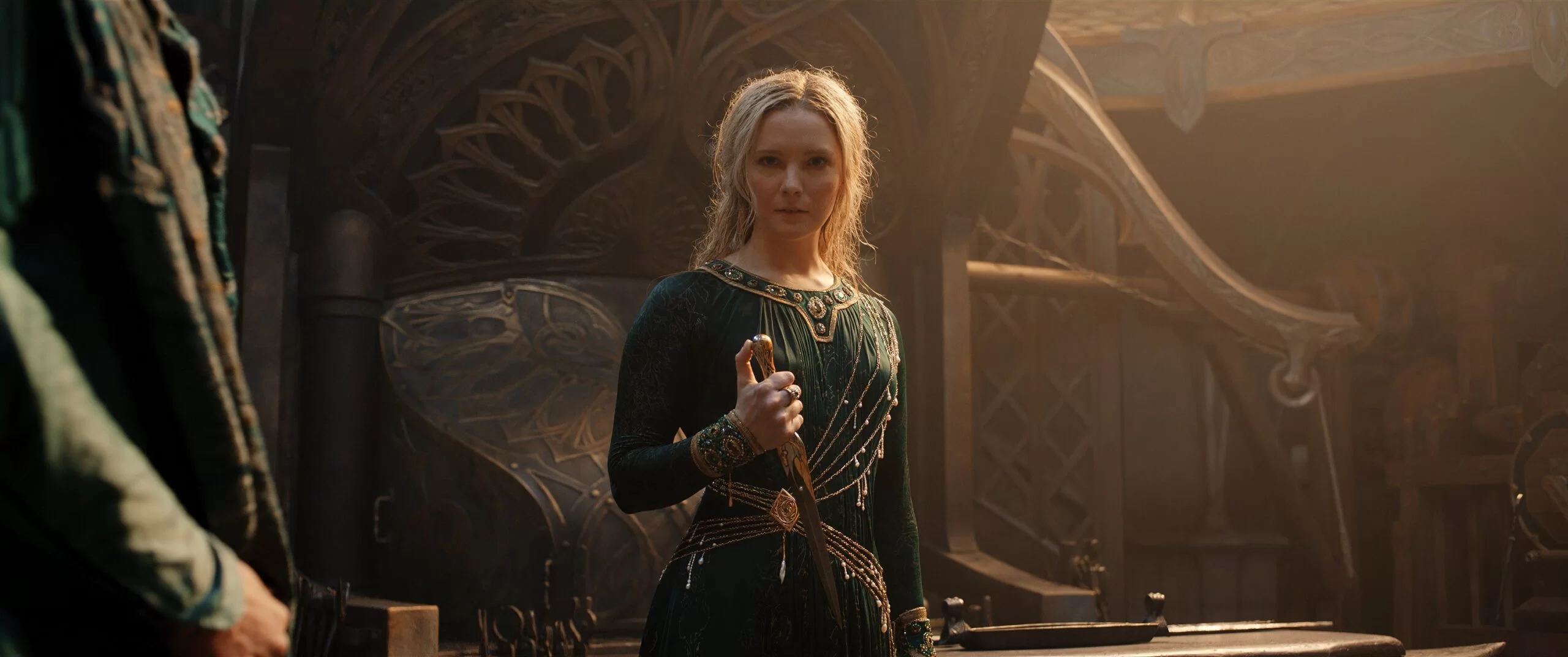
Elves
As Tolkien developed his legendarium, he created numerous different groups of Elves, as anyone who has read The Silmarillion knows. The differences between these groups of Elves played a major role in events of the First Age. Even in the Second Age events were influenced by these differences, such as the founding of the Kingdom of Lórien and the Woodland Realm, and certain events in the two major wars with Sauron. During the Second Age three groups of Elves were most relevant to events that occurred in Middle-earth: the Ñoldor, the Sindar, and the Nandor (or Silvan Elves). The Ñoldor were a group of Elves who migrated from Middle-earth to Valinor, many of whom returned to Middle-earth after Morgoth darkened the Two Trees. Among the Elves, the Ñoldor were particularly known for their knowledge and craftsmanship. They were also the most warlike. The Sindar (or “Grey Elves”) were a group of Elves who began a journey to Valinor but stopped before crossing the Sea, preferring to stay in Beleriand. The Nandor were a group of Elves (most of whom were closely related to the Sindar) who also took a journey towards Valinor, but stopped before crossing the Misty Mountains, although some of these eventually made their way to Beleriand, becoming known as the Laiquendi, or “Green Elves”. There was also a group of Elves called the Falmari who were closely related to the Sindar, but who made the journey across the sea to the coast of Valinor. The Sindar, Falmari, and most of the Nandor originally belonged to a group of Elves called the Teleri. Additionally, there was a group of Elves called the Vanyar who were the closest to the Valar and never returned to Middle-earth, except temporarily during the War of Wrath, so not much is written about them.
The Rings of Power does lightly touch on some of these differences. Arondir was described in the promotional phase as a Silvan Elf. (Given his origin in Beleriand, he would presumably be a Green Elf specifically.) Also, Lindon is introduced as the “Capital of the High Elves”, where “High Elves” is referring to the Ñoldor, since they had once lived in Valinor. Even more explicitly, Galadriel introduces herself to the Númenórean court as one of the Ñoldor. (However, I was slightly disappointed to hear Morfydd Clark pronounce it simply as “Noldor”. The Ñ is not pronounced as in Spanish. Rather, it is the same sound as the last two letters of the English word “song”, but occurring word initially. Perhaps Tolkien would have better encouraged this pronunciation if he had spelled the word “Ngoldor”, or “Ŋoldor”. Or perhaps not.) The Sindar are not mentioned specifically, though their language is used in many names of people and places, and even when characters are speaking to horses. (Otherwise the Elves all seem to speak Quenya, whether or not they are Ñoldor, whereas according to Tolkien Ñoldorin Quenya was essentially Elven Latin by the Second Age.) Despite these scattered references, the differences between groups of Elves seems to have little effect on anything, at least in Season 1. From Celebrimbor to Galadriel to Arondir, they all seem to be just Elves. The notable exception is Elrond, not because of which particular group of Elves he claims loyalty to, but because he is Half-Elven, a point Gil-galad raises, and a point Elrond himself raises to the Dwarves.
Galadriel
Galadriel is from the works of Tolkien, first appearing in the “Lothlórien” chapter of The Lord of the Rings. Her name means “Maiden Crowned with Radiance” in Sindarin. In her youth in Valinor, however, she was known as Artanis, Quenya for “Noble Woman”, and was also given the name Nerwen (“Man-maiden”) by her mother due to her stature and temperament. However, these names are not from The Lord of the Rings, so Amazon likely does not have the right to use them. Galadriel was born in the city of Tirion in Valinor in the First Age. Her father was Finarfin, son of Finwë, who was the King of the Ñoldor. Her mother was Eärwen of the Falmari. Galadriel was unusually tall, even for a woman of the Ñoldor, and enjoyed participating in athletic contests. In The Lord of the Rings Tolkien described her as having golden hair, though in later writings he said the gold was “touched by some memory of the starlike silver of her mother” as if “the light of the Two Trees had been snared in her tresses” (Unfinished Tales, “The History of Galadriel and Celeborn”).
After the darkening of the Two Trees, Galadriel went to Middle-earth with her three brothers and many other Ñoldor. All three of her brothers died in Beleriand during the First Age. Accounts differ as to where she first met Celeborn, but by all accounts they met during the First Age, and were married at the latest in the early Second Age. In the early Second Age Galadriel’s husband Celeborn was Lord of Harlindon, the southern part of Lindon where many Sindar dwelled. Later they crossed the Blue Mountains into Eriador and lived by Lake Nenuial. Their daughter Celebrían was born around this time. In early accounts they also had a son named Amroth, but he was later made the son of Amdír. Some 700 years after the beginning of the Second Age, Celeborn and Galadriel moved to Eregion. In some accounts they ruled Eregion before Celebrimbor. This brings us up to date (more or less) with the situation in The Rings of Power.
In The Rings of Power Galadriel is given the title “Commander of the Northern Armies”. This title is not from the writings of Tolkien. She also says she is of the “Golden House of Finarfin”, a phrase which is from Tolkien, and refers specifically to the golden hair of most descendants of Galadriel’s father Finarfin. I will not go into the many things Galadriel does in The Rings of Power, as that would make this article overlong, and more properly belongs to the article on events anyway.
In The Rings of Power Galadriel is portrayed by Morfydd Clark, who apparently has naturally reddish hair. However, she has golden hair in the show, which is in keeping with Galadriel’s description in The Lord of the Rings, if not exactly with Tolkien’s later conception of her. Clark is rather short, though, which is quite apparent in some scenes. She should be shorter than either Elendil or Sauron, of course, but even Theo, a teenage boy from Middle-earth, appears to be slightly taller than her. There are tricks for making actors appear taller, but perhaps the fact that she was wearing armor or barefoot in many scenes made such solutions untenable.
Finrod
Finrod is also from the works of Tolkien. He figures prominently in the First Age tales of The Silmarillion, particularly in the tale of Beren and Lúthien. His name is a Sindarized form of his Quenya given name, Findaráto, or “[Golden-]Haired Champion”. He is commonly known as Finrod Felagund because while in Beleriand he lived in the underground fortress of Nargothrond, and Felagund is either from Khuzdul (Dwarvish) Felakgundu (“Hewer of Caves”) or from Sindarin, meaning “den-dweller” or “badger”. Finrod was born in Tirion in the First Age, the son of Finarfin and Eärwen. He was their eldest son, and had two younger brothers, and a younger sister, Galadriel. His hair was golden, as one would expect for a member of the “Golden House of Finarfin”.
In The Rings of Power Finrod is shown after his death with claw marks on his arm and the sigil of Sauron carved into his chest. He was also armed with a dagger with a hilt of silver and gold, which Galadriel retrieves from his tomb. The claw marks are consistent with the manner in which Finrod died in Tolkien’s writings, but his dagger and Sauron’s sigil were invented for the show.

Thondir
Thondir was a member of Galadriel’s expedition to the Northern Waste. He had red hair. He seems to have been her lieutenant, and led the mutiny against her. Thondir is a character created for The Rings of Power. However, his name seems to be Sindarin, possibly meaning “root man” (thond + dîr) or “pine man” (thôn + dîr).
Rían
Rían was a member of Galadriel’s expedition to the Northern Waste. He had blond hair, and discovered a snow-troll while exploring the fortress of Dúrnost. He apparently survived, and later sailed West to Valinor. Rían is a character created for The Rings of Power. However, his name seems to be a Sindarin word meaning “crown-gift” or “queen”. Either way, it is a feminine name. Whether that has some significance or is merely an error is not clear.
Elrond
Elrond is from the works of Tolkien. He was originally created for the tale of Númenor, but around the same time Tolkien was writing The Hobbit, and he decided to include Elrond as a character in the chapter “A Short Rest”. Elrond’s name is Sindarin, meaning either “Elf of the Cave” (because he was found in a cave as an infant) or “Vault of Stars”. He was born late in the First Age in the Havens of Sirion in Beleriand, the son of Eärendil and Elwing. He was descended from the House of Hador (of the Edain) and the Ñoldor on his father’s side, and the House of Bëor (also of the Edain) and the Sindar on his mother’s side, therefore being “half-elven” on both sides. He also had a twin brother, Elros. Elrond had dark hair and gray eyes.
After the defeat of Morgoth at the end of the First Age, Elrond and Elros were given the choice to live as Elves or Men. Elrond chose to live as an Elf, but Elros chose to live as a Man, becoming the leader of the Edain and the first King of Númenor. Elrond, for his part, lived in Lindon, and later Rivendell, and served under High King Gil-galad, becoming his herald at least by the time of the War of the Last Aliance which concluded the Second Age. In The Hobbit, which takes place near the end of the Third Age, Elrond is described as follows:
“He was as noble and as fair in face as an elf-lord, as strong as a warrior, as wise as a wizard, as venerable as a king of dwarves, and as kind as summer.”
In The Rings of Power Elrond is portrayed by Robert Aramayo, who seems to have natural brown hair, which nevertheless generally appears light brown or dark blond in the show. (That is, not the “dark hair” Elrond is described as having.) Perhaps it is only the effect of lighting, but his hair seems darker in cast interviews shortly before the show was released. On the other hand, many fans of Tolkien’s books appreciated Aramayo’s portrayal of Elrond, which provides quite a contrast against Hugo Weaving’s “Grumpy Elrond” of the live-action films, particularly in The Lord of the Rings trilogy.
In the show Elrond is excluded from a meeting that is for “Elf lords only”. This is curious, given that he was a descendant of Finwë, Fingolfin, and Turgon, all Kings of the Ñoldor, on his father’s side, and a descendant of Thingol and Dior, Kings of the Sindar of Doriath, on his mother’s side. Indeed, apart from Gil-galad and Galadriel, it is difficult to think of a more legitimate candidate for King of the Elves of Lindon. He was younger than either of them, but he is presumably at least a thousand years old when he is introduced to us.
Gil-galad
Gil-galad was an Elven-king, as anyone who has read The Lord of the Rings knows. Like Elrond, he was also created for the tale of Númenor, but when Tolkien decided that Bilbo’s magic ring actually once belonged to Sauron, he quickly incorporated references to Gil-galad in the sequel to The Hobbit (i.e., The Lord of the Rings). Gil-galad does appear in the New Line films, but only briefly in a couple of scenes, in a non-speaking role, and his name is not mentioned.
Gil-galad’s time and place of birth are not specified. In fact, Tolkien gave him several different origins. First he was a descendant of Fëanor, then a son of Finrod Felagund, then a son of Fingon (a cousin of Finrod), then finally the son of Orodreth (a nephew of Finrod and Galadriel). Christopher Tolkien ultimately made him a son of Fingon in the published Silmarillion, and even altered text in Unfinished Tales for consistency, because at the time he believed the Orodreth parentage was an idea his father had not developed well enough, but he later regretted doing so and wished he had simply left it ambiguous. However, whatever background one goes with, he was most likely one or two generations below Galadriel.
Until the publication of The Nature of Middle-earth in 2021, no description by Tolkien of Gil-galad’s physical features was known publicly. In The Nature of Middle-earth Gil-galad is described as having silver hair. Previously Tolkien fans had been divided on whether Gil-galad had dark or blond hair. As a son of Fingon, who had dark hair, he would likely also have had dark hair. However, as a descendant of Finarfin, either through Finrod or Orodreth, it is possible his hair would have been blond. Silver-haired Gil-galad is also described as a close relative of Galadriel’s, so arguably this version may depend on descent from Finrod, or especially Orodreth, who had a Sindarin wife.
Gil-galad means either “starlight” or “radiant star” in Sindarin, the element galad being the same as in Galadriel’s name. It was, in fact, not his given name. He was so called because of the brightness of his armor and shield. Also, on his shield he bore a device of twelve white stars on a field of blue. As a warrior he was known for his spear, Aeglos, Sindarin for “Snowthorn” (a plant that grew in Beleriand) or “Icicle”. Gil-galad became High King of the Ñoldor upon the death of Turgon in the Fall of Gondolin. He was then living in the Havens of Sirion. He was High King during the War of Wrath in which Morgoth was overthrown, and afterwards during the Second Age. After the destruction of most of Beleriand in the War of Wrath, Gil-galad ruled the Elves who lived in the land that remained, which became known as Lindon.
In The Rings of Power Gil-galad is portrayed by Benjamin Walker, who fairly closely resembles Mark Ferguson, the actor who portrayed him in the New Line films. Both have dark hair, suggesting that Gil-galad is a son of Fingon in show and movie canon. (In fairness to Amazon, The Nature of Middle-earth was not published until filming of Season 1 was complete, so they were likely unaware Tolkien once described him as having silver hair.) He is usually shown wearing gold, rather than the silver beloved by the Elves, and for which he was named. However, he is shown carrying his spear Aeglos in the last episode of the season.
As for Gil-galad’s characterization in The Rings of Power, it was significantly less successful among book fans than that of Elrond. Indeed, it seems to some extent that the “Grumpy Elrond” of the New Line films has been replaced by the “Grumpy Gil-galad” of The Rings of Power. Although we have very little characterization of him from Tolkien’s works, what we do know of him suggests that he was a valiant warrior and a wise leader. In “The Mariner’s Wife”, in Unfinished Tales, it is Gil-galad who recognizes that a servant of Morgoth is behind events taking place in lands to the east, and who proposes an alliance with Númenor. In The Rings of Power it is Galadriel, acting on her own, who fills this role. Gil-galad, on the other hand, proclaims peace some one thousand years after the defeat of Morgoth, and spends the season preoccupied with the imminent fading of the Elves. In Tolkien’s writings the fading of the Elves was a much more gradual thing. The Rings of Power were not created to forestall an immediate crisis, and Gil-galad was not at all involved in their creation, whereas in the show they are created as a result of Gil-galad’s concern.
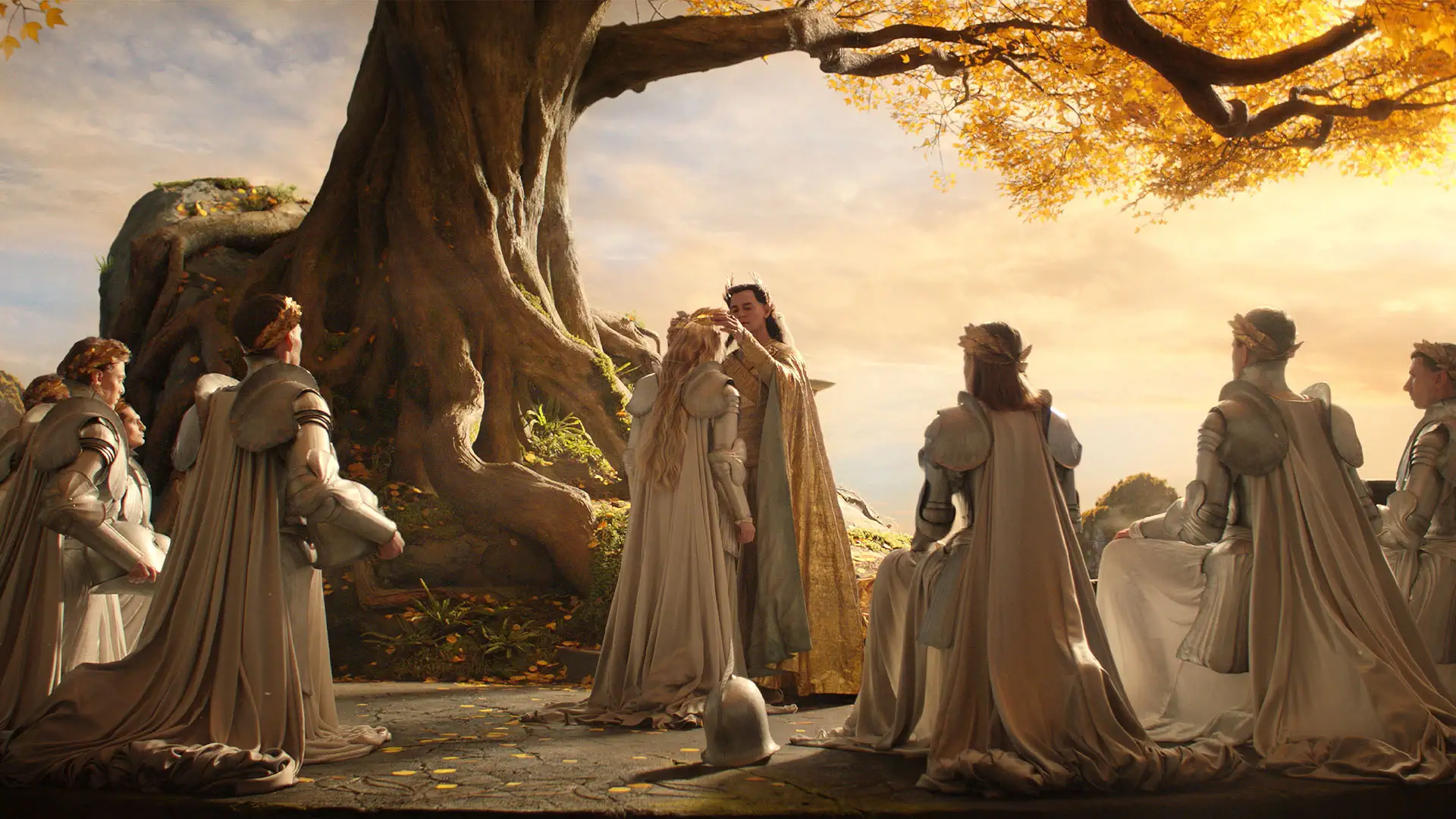
Arondir
Arondir was an Elf who was stationed in the Southlands in The Rings of Power. He is an original character in the series, and is not from the writings of Tolkien. He is portrayed by Ismael Cruz Córdova. In pre-show publicity he was described as a “Silvan Elf”. Some fans interpreted that to mean that he was one of the Avari, those who refused to take the journey to Valinor, although the Silvan Elves (also known as the Nandor) were actually those who undertook the journey to Valinor but stopped short of the Misty Mountains. In the show, however, Arondir tells Adar he was originally from Beleriand. That would make him one of the Sindar, one of the Ñoldor, or (given his description as a “Silvan Elf”) one of the Laiquendi, or “Green Elves”. He was formerly a gardener. At the time of Season 1 he has been stationed in the Watchtower of Ostirith for 79 years. His name appears to be Sindarin, likely meaning “Noble Man” (arod + (n)dîr).
Médhor
Médhor was an Elf who accompanied Arondir to the village of Tirharad, and was later captured by Orcs. He is also an original character in The Rings of Power, portrayed by Augustus Prew. The meaning of his name is not certain. Although one might expect it to be a Sindarin name, Parf Edhellen notes that in standard Sindarin the long vowel e typically became a long i sound. Possibly it is intended to be from a related language or dialect. Parf Edhellen suggests that the name may come from the Doriathrin/Ilkorin word mêd, meaning “wet”. Ilkorin, the language of the “Dark Elves”, and Doriathrin, the language of the Elves of Doriath, were conceptual precursors of Sindarin. Eventually Tolkien decided to use Ñoldorin, originally intended to be the language of the Ñoldor, as the basis of Sindarin, and to have the Ñoldor speak a dialect of Quenya instead.
Revion
Revion was the commander of the Elves who were stationed at the Watchtower of Ostirith, and was later captured by Orcs. Revion is also an original character in “The Rings of Power”, portrayed by Simon Merrells. His name appears to be related to the Sindarin verb revia- meaning “to fly”, “to sail”, or “to wander”.
Celebrimbor
Celebrimbor was the Lord of Eregion and also a great craftsman. He is from the works of Tolkien, being first mentioned by name as the Elf of Hollin (Eregion) who carved the inscription on the Doors of Durin. Tolkien later incorporated him into the chapter “The Council of Elrond” as the maker of the Three Elven Rings, and expanded even further on his background in the Appendices, and in later writings.
Tolkien described Celebrimbor in Appendix B: “The Tale of Years” as a descendant of Fëanor. He later expanded on this by making him the son of Curufin, who was a son of Fëanor. This version of Celebrimbor’s background appeared in the published Silmarillion, and is undoubtedly the most well-accepted version among Tolkien fans. Nevertheless, Tolkien either forgot or became dissatisfied with this version, because he later wrote several contradictory backgrounds for Celebrimbor. In one of the most detailed backgrounds he was an Elf of Gondolin (and so still a Ñoldo, though not likely a Fëanorian) who became a follower of Celeborn and Galadriel. In another he and Celeborn were both Falmari who left for Middle-earth along with Galadriel. And in yet another Celebrimbor was a Sinda of Doriath who was a descendant of the minstrel and loremaster Daeron, who invented cirth (runes). In this version Celebrimbor introduced this writing system to the Dwarves of Khazad-dûm, who found it convenient for carving in stone.
Celebrimbor was born in Valinor in the version in which he is a grandson of Fëanor. Tolkien did not describe his appearance. However, Curufin had dark hair and bore a striking resemblance to his father Fëanor. And indeed, most of the Ñoldor, with the exception of the House of Finarfin, are said to have had dark hair. For this reason Celebrimbor is typically depicted with dark hair as well. As a grandson of Fëanor he was also one generation below Galadriel, although the difference in ages of siblings could make them of similar age. His name is Sindarin, meaning “Silver Fist”, though this would be a translation of the original Quenya (Telperinquar/Telpinquar/Tyelpinquar) or Telerin (Telperimpar) in the versions in which he was a Ñoldo or Falmar.
In The Rings of Power Celebrimbor is portrayed by Charles Edwards, who has light brown or dark blond hair and is considerably older than Morfydd Clark. He replaced Tom Budge in the role, who is of a similar age to Morfydd Clark, but also has a similar hair color to Charles Edwards. Charles Edwards happened to be filming a series called Under the Vines in New Zealand at the time the role of Celebrimbor was recast, which was likely a key reason he was chosen for the part (in addition to his acting ability), as the country was closed due to COVID-19. Although he is not specifically said to be the grandson of Fëanor in the show, he possesses the “hammer of Fëanor”, and Charles Edwards has mentioned his character’s descent from the famous Elven craftsman in interviews.
Adar
Adar was an Elf who was captured and tortured by Morgoth and became a progenitor of the Orcs. He is an original character created for The Rings of Power, and was portrayed by Joseph Mawle in Season 1 of the show. In Season 2 he will be portrayed by Sam Hazeldine. Although this specific character is original, Tolkien did write that the Orcs were descended from Elves who were captured and twisted by Morgoth. This was only one version of the origin of Orcs. Tolkien came up with several versions, but the Elf origin is the most well-known one, as it was published in The Silmarillion and also referenced in the New Line films. (In The Lord of the Rings Treebeard says Orcs were made in mockery of Elves, but does not elaborate on the process.)
Adar’s precise background is not clear. From his talk with Arondir we know he can speak Quenya and is familiar with Beleriand. He also wears armor and carries a sword similar to those of Galadriel and her companions. Because of this, some Tolkien fans have assumed Adar was a Ñoldo. However, he could have just as easily taken his sword and armor from the body of a dead Elf, as some of his Orcs (Pardon, Uruks) appear to have done. Adar’s name is Sindarin, and simply means “father”. I imagine this is a title given to him by the Uruks. It reminds me of Christopher Tolkien’s hypothesis that Attila, the ruler of the Huns, was so named by his Germanic subjects (Ostrogoths, Gepids, Rugians, Heruls, and Suebi) because they regarded him as their “little father”. (The Letters of J.R.R. Tolkien, end notes to Letter 205 to Christopher Tolkien) In The Rings of Power Galadriel refers to Adar as one of the “Moriondor”, or “Sons of the Dark”. This particular name was not used by Tolkien, but it does derive from Quenya, and in fact the singular form Morion (“Dark One”) was a name Tolkien used for the Dark Lord Morgoth.
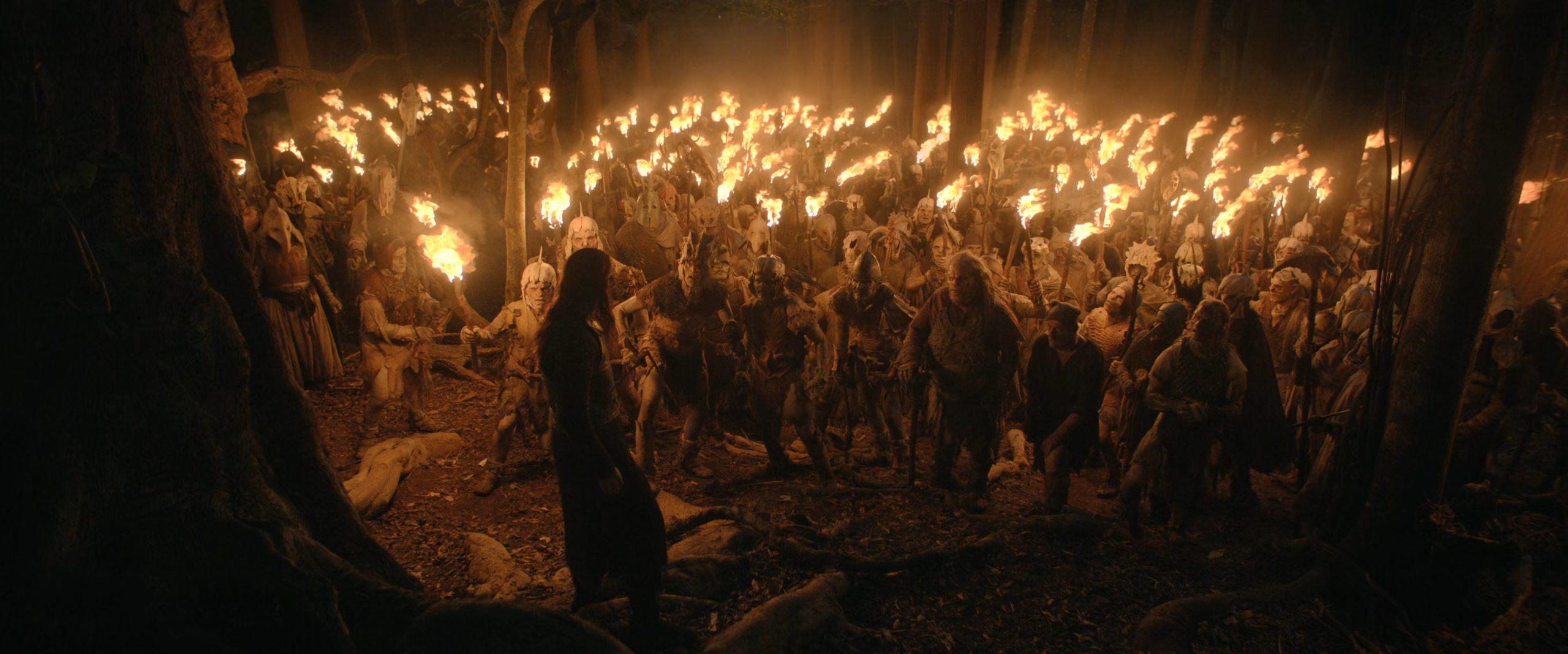
Fëanor
Fëanor is a character from Tolkien who has a prominent role in The Silmarillion. He was the eldest son of Finwë, King of the Ñoldor, and his only child by his first wife, Míriel (not to be confused with Míriel of Númenor). He was a great craftsman and innovator. He is credited with inventing Tengwar, the most common form of writing among Elves and other races from the First through the Third Age. He is also said to have created the palantíri (or “Seeing Stones”), and most notably, the Silmarils, three stones that captured the light of the the Two Trees.
When the Dark Lord Melkor darkened the Two Trees, killed Finwë, and stole the Silmarils, it was Fëanor who named him “Morgoth” (Sindarin for “Dark Enemy”, presumably a translation from the original Quenya). In his wrath, Fëanor also swore an oath with his sons to recover the Silmarils from Morgoth and slay anyone (not just Morgoth) who got in their way. This oath led to much strife and sorrow, and Fëanor and his sons tended to have an antagonistic relationship not just with Morgoth and his minions, but also with other Elves, including the other Ñoldor who were descended from Finwë’s second wife, Indis (e.g., Finrod and Galadriel).
Fëanor was born in Tirion in Valinor during the First Age, but after the darkening of the Two Trees he led many of the Ñoldor to Beleriand in Middle-earth in an attempt to take revenge upon Morgoth for the death of Finwë and the theft of the Silmarils. He had dark hair. His name is a half-Sindarized form of the original Quenya Fëanáro (“Spirit of Fire”). In full Sindarin it would be Faenor.
Fëanor does not appear as a character in the first season of The Rings of Power. However, he is mentioned by name in a conversation between Elrond and Celebrimbor. He was an ancestor of Celebrimbor and the creator of the Silmarils, and someone to whom Celebrimbor looks not only with admiration and pride, but also with a bit of envy. Celebrimbor possesses “Fëanor’s hammer”, an artifact created for the show, although as a craftsman it stands to reason that Fëanor would have had such a tool. Also, although neither Fëanor nor his sons are explicitly mentioned in the prologue to The Rings of Power, the scene with Finrod raising his sword with other Elves following the destruction of the Two Trees is evocative of the Oath of Fëanor. However, as a son of Finarfin, Finrod did not take part in that oath. Some have argued that in The Rings of Power Finrod and Galadriel both seem to have taken on qualities similar to those of Fëanor and his sons. Some have also claimed that the Fëanorian star appears on the armor Galadriel wears on the expedition from Númenor to the Southlands, though in the context of the show this seems to be just a symbol representing the Elves in general.
Finarfin
Finarfin is a character from Tolkien’s writings who had many notable descendants. He was the youngest child of Finwë, King of the Ñoldor, and his second wife, Indis. He was the younger half-brother of Fëanor and full brother of Fingolfin. When Fëanor led the Ñoldor to Middle-earth, Finarfin eventually decided to return to Valinor with a small group of Ñoldor, though all four of his children (including Finrod and Galadriel) chose to continue on to Middle-earth. Consequently, not much is said of Finarfin, although he did come with the Host of the Valar to defeat Morgoth in the War of Wrath at the end of the First Age.
Finarfin was born in Tirion in Valinor during the First Age. He inherited the golden hair of his mother Indis, who was one of the Vanyar Elves. (Most of the Ñoldor had dark hair.) Many of Finarfin’s descendants also had fair hair, to the point that they were called the “Golden House of Finarfin”. Finarfin is a Sindarized form of his Quenya name Arafinwë (“Noble Finwë”).
Finarfin does not appear as a character in the first season of The Rings of Power, but he is mentioned twice. When introducing herself to the Númenórean court, Galadriel says she is of the “Golden House of Finarfin”. Later on Míriel addresses her as “Daughter of Finarfin”.
Celeborn
Celeborn is a character from Tolkien’s writings. He and Galadriel were created together for the “Lothlórien” chapter in The Lord of the Rings, as the Lord and Lady of Lothlórien. Although Tolkien settled on his name even before he settled on Galadriel’s name (albeit spelling it “Keleborn” at first), his view of Celeborn’s backstory changed even more radically than that of Galadriel’s backstory over time.
It seems likely that Tolkien initially conceived of Celeborn as a Nandorin (“Silvan”) Elf either native to Lothlórien or having migrated there from the east. Galadriel, however, soon became associated with the Ñoldor and integrated into the House of Finarfin, which led to various revisions of Celeborn’s history. In the text of The Lord of the Rings Galadriel implies that she left Beleriand on her own before the end of the First Age, and only met Celeborn when she arrived in Lothlórien. However, this is contradicted in Appendix B: “The Tale of Years”, in which Celeborn and Galadriel reside together in Lindon (the remnant of Beleriand) at the beginning of the Second Age. In this version Celeborn is a kinsman of Thingol, King of Doriath, and therefore presumably a Sindarin (“Grey”) Elf. Tolkien retained this version of Celeborn’s backstory for some time after the publication of The Lord of the Rings, but eventually discarded it towards the end of his life in favor of a version in which Celeborn was one of the Falmari Elves of Valinor. (This is the version in which his original name was “Teleporno”.) In this version Celeborn and Galadriel met in Valinor and sailed to Middle-earth together, instead of Galadriel traveling with her brothers by land across the icy Helcaraxë.
Celeborn was tall, with long, silver hair. His name is Sindarin, meaning “Silver” and “Tall”. By most accounts he was the great nephew of Elwë (Sindarin: Elu Thingol), who was King of the Teleri, and later King of the Sindar of Doriath as the Teleri broke up into several different groups. As a Sinda Celeborn was the grandson of Thingol’s younger brother Elmo, and the son of Galadhon. As a Falmar he was the grandson of Thingol’s younger brother Olwë, but his father’s name is not known. In that version he and Galadriel would be first cousins, since Galadriel was the daughter of Olwë’s daughter, Eärwen.
Celeborn and Galadriel married either in the First Age or, in at least one account, at the beginning of the Second Age. They had a daughter, Celebrían, and in some accounts also a son, Amroth, though Amroth was later made the son of Amdír. At one point Tolkien made Amroth the son of Celeborn by a previous marriage, but he seems to have quickly discarded this idea. Galadriel called him “Celeborn the Wise”.
Celeborn does not appear in the first season of The Rings of Power, but Galadriel mentions him by name in a conversation with Theo. In the show they were presumably married some time during the First Age, in Beleriand. Galadriel’s account of her meeting with Celeborn is reminiscent of the tale of Beren and Lúthien, in which Beren comes across Lúthien dancing in the forest and falls in love with her. Celeborn later goes to war and never comes back, so Galadriel presumes he is dead. Presumably this happened before she took up Finrod’s dagger and became a warrior herself. This is quite different from any of Tolkien’s accounts, in which Celeborn and Galadriel are together throughout the Second Age, although there was one point during Second Age in which Celeborn and Galadriel were separated for a while by a war in which Celeborn fought, one which perhaps may feature in Season 2. Whether Celeborn himself will show up in this season remains to be seen, but he is likely no more dead than Aragorn was when he went over the cliff in New Line Cinema’s The Two Towers.
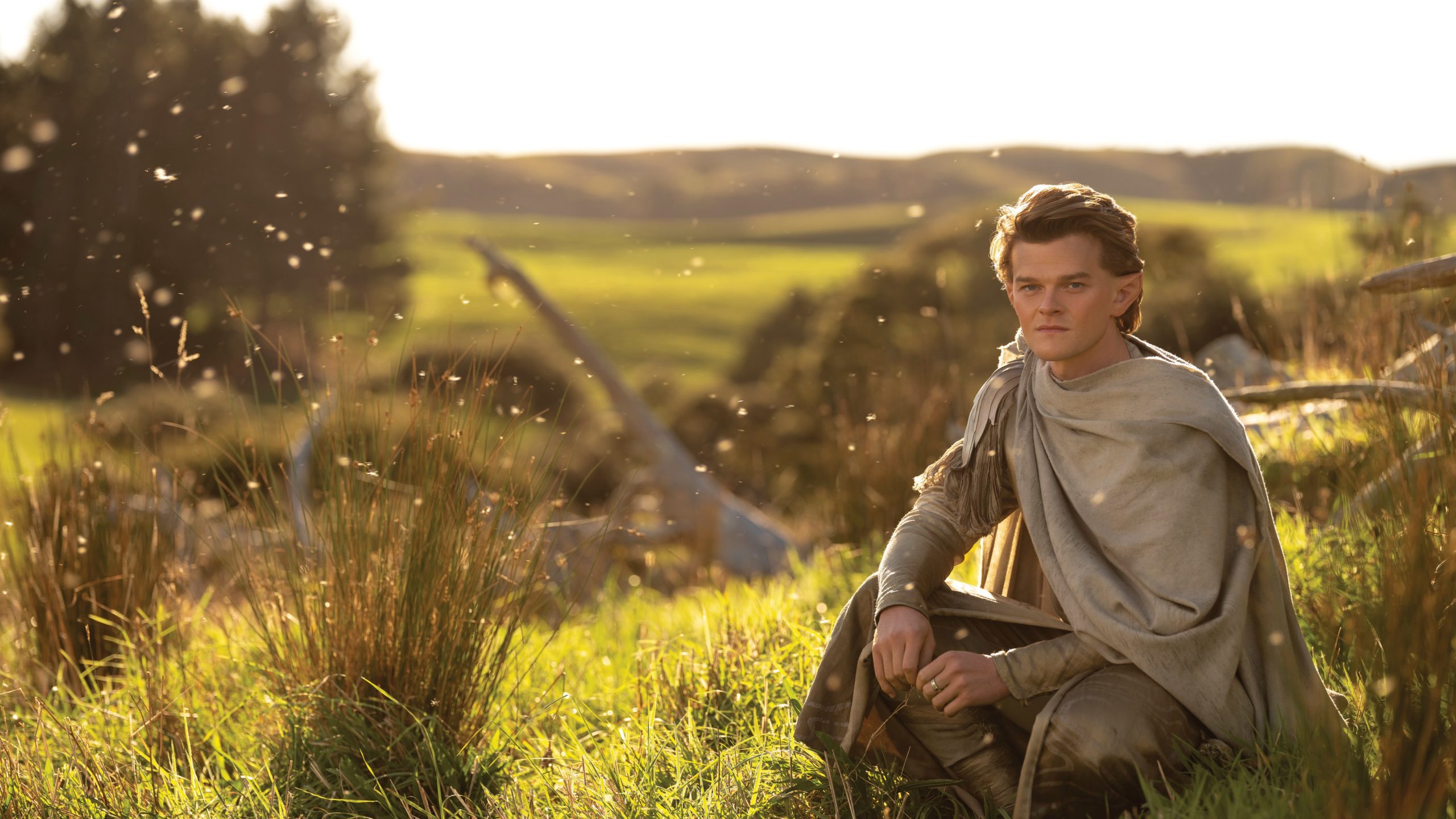
Conclusion Regarding the Elves
Of eleven named Elven characters, five are from the writings of Tolkien―slightly less than half. If we include characters who are only referenced by name, then eight of fourteen characters are from the writings of Tolkien, or slightly more than half. This should not be surprising, given that Tolkien himself wrote relatively little regarding the Second Age, and therefore any adaptation would need to add characters. What is surprising, perhaps, is that none of the named original characters are introduced to us in the Elven realms of Lindon or Eregion. Instead, they are all introduced to us either on an expedition to the Northern Wastes, or in a remote outpost in a place called the “Southlands”. None of them ultimately end up in Lindon or Eregion, either. Of course, there are numerous background extras in both Lindon and Eregion, but for a show that is going to cover the drama of the Second Age, it would seem to me to be important to introduce secondary characters who will be directly involved in that drama as soon as possible.
Probably not much more need be said regarding the background extras. However, some Elves are referred to visually, rather than specifically mentioned. For example, in Lindon there is a statue of Finrod carved from a tree, but in the same place there are carvings of other Elves, notably Lúthien. Also, one Elf is featured fairly prominently in one episode, but is not given a name: the Elf who fought the Balrog in the “Song of the Roots of Hithaeglir”. This entire event is not from the writings of Tolkien, as might be surmised from Elrond’s estimation of the account as “apocryphal”. All three Silmarils were accounted for, and there was never known to be a battle over a Silmaril lodged in a deciduous tree in the peaks of the Misty Mountains. However, the unnamed Elf’s battle with the Balrog is reminiscent of deeds performed in the First Age, notably by Ecthelion and Glorfindel, both of whom fought Balrogs during the Fall of Gondolin.
Setting aside the actual meanings of the invented names, they do appear to be Sindarin, and fit well phonologically with the existing names (except possibly for Médhor) as Tolkien intended. I don’t consider myself competent to judge the actual meanings of the names, but others who study the Elvish languages have raised questions about some of the names. Nevertheless, all in all, I think the Elves as characters (as distinct from the actual events they were involved in) are about what one could expect from an adaptation of Tolkien’s works set in a time period of which he wrote very little, although there are plenty of characters created by Tolkien, both well-known and obscure, who Amazon could introduce into the show if they wish to do so. I do think that, just as many readers of The Silmarillion complain about the number of characters with similar names beginning with F, Amazon Studios likely felt that it might be a bit much to introduce all the Second Age characters whose names begin with C in the first season.
My next article in this series will be about Halflings and Dwarves in The Rings of Power.

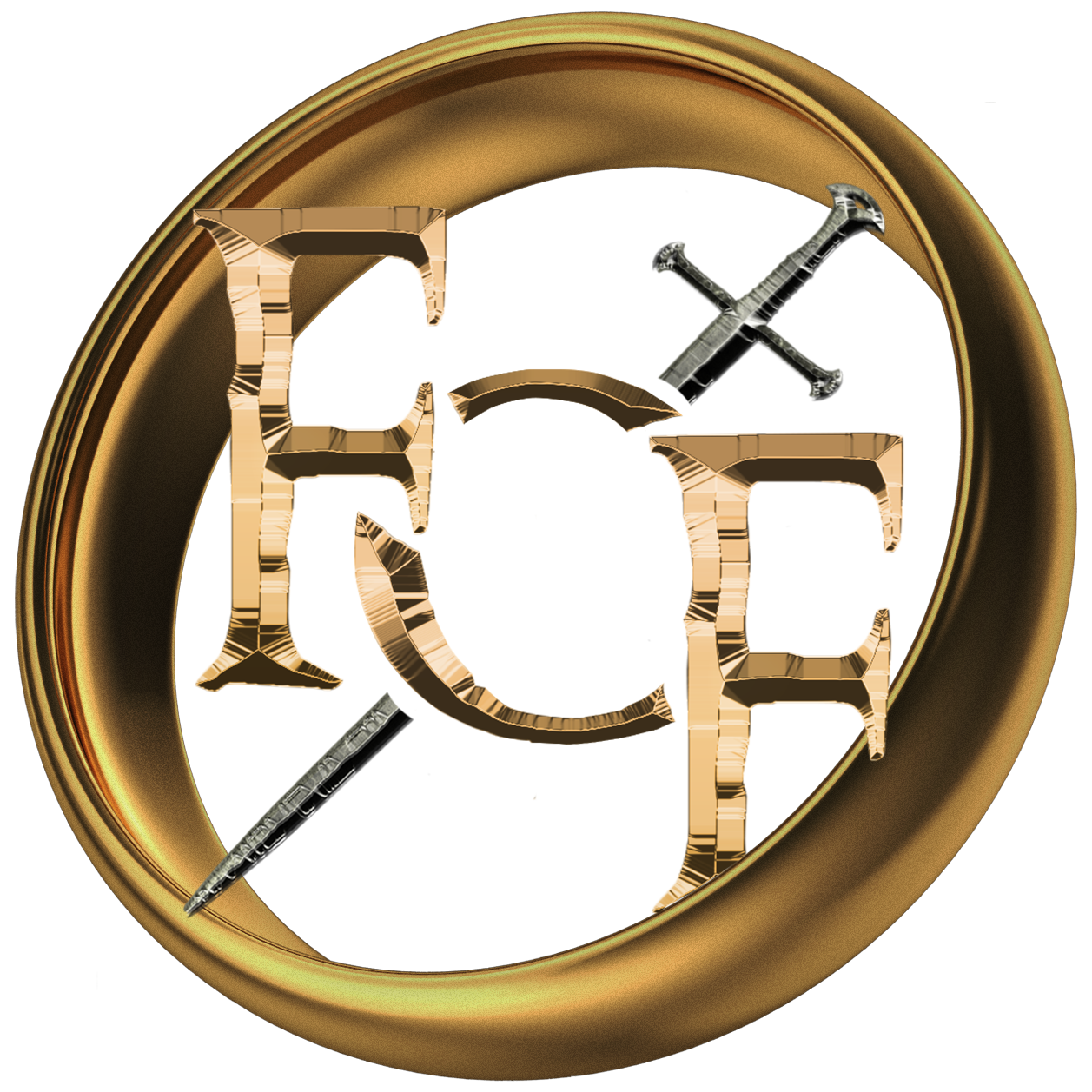
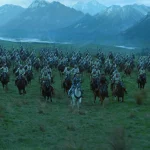
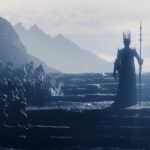
No Comments